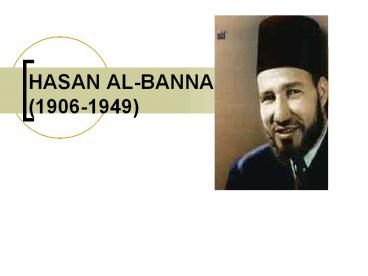HASAN AL-BANNA (1906-1949) PowerPoint PPT Presentation
1 / 13
Title: HASAN AL-BANNA (1906-1949)
1
HASAN AL-BANNA(1906-1949)
2
Biography of Hasan al-Banna
- Born into a religious family and spent his early
years to study the Quran, Hadith, Fiqh and
language. - Sufi, school-teacher, and religious activist.
- He was educated at Damanhur and then at the Dar
al-Ulum in Cairo where he began to spread the
dawa mission by preaching in the mosques and
meeting-places. - He was appointed in 1927 as a government
school-teacher, and a year later (1928), he
founded the Muslim Brotherhood based on the cell
principle. - In 1936, he advocated the cause of Palestine
Arabs, and became involved in politics. - In 1948, the Prime Minister al-Nukarashi Pasha
was assassinated by a member of the Muslim
Brotherhood. - Al-Banna was then assassinated by the government
agents in 1949.
3
The Muslim Brothers
- Salafi
- Sufi
- Political Organization
- Athletic Group
- Business corporation
- Education group
4
Ideology, Goal, Organization, and its Evolution
of the Movement
- Ideology
- Socially engaged in the issue of poverty, immoral
society, and against foreign domination. - An Islamic ideology with grass-root
social-political activism. - Main Goal
- God is our objective, the Quran is our
Constitution, the Prophet is our leader, struggle
is our way, and death for the sake of God is the
highest of our aspirations. - Organization
- Federated structure of authority with headquarter
in Cairo. - Network of Branch offices throughout the cities
and villages. - Evolution
- Founded in 1928, it evolved quickly by
establishing 5 branch offices by 1930, 15 by
1932, and 300 by 1938. - By the time of Hasan al-Bannas death in 1949,
there were 2000 branch offices.
5
Conception of Jihad
- Who? Individual Obligation
- Against Whom? Jihad is against all who do not
embrace Islam - Rules of Jihad
- Martyrdom
- Al-Nizam al-Khass (Special Military Apparatus)
6
Ambiguities of Al-Bannas Approach
- Conciliation with Democratic technique
- Military strategy
7
SAYYID QUTUB(1906-1966)
8
Biography of Sayyid Qutub
- Qutub was raised in the Egyptian village of Musha
and educated from a young age in the Qur'an. He
moved to Cairo, where he received a Western
education between 1929 and 1933, before starting
his career as a teacher in the Ministry of Public
Instruction. - Although Sayyid Qutub started out as a literary
critic, he became radicalized on a trip to the
United States. Qutub travelled through America
from 1948 to 1950 - Joined Ikhwan al Muslimin (The Muslim
Brotherhood) 1951 - After the attempted assassination of Nasser in
1954, the Egyptian government used the incident
to justify a crackdown on the Muslim Brotherhood,
imprisoning Qutub and many others for their vocal
opposition to various government policies. - Qutub was let out of prison at the end of 1964,
for only 8 months before being rearrested in
August 1965. - Qutub was sentenced to death as the leader of a
group planning to assassinate the President and
other Egyptian officials and personalities. On 29
August 1966, Qutub was executed by hanging.
9
Main publications
- Al-Adala al-Ijtima'iyya fi'l-Islam (Social
Justice in Islam), 1949 - Ma'arakat al-Islam wa'l-Ra's Maliyya (The Battle
Between Islam and Capitalism), 1951 - Al-Salam al-'Alami wa'l-Islam (World Peace and
Islam), 1951 - Fi Zilal al-Qur'an (In the Shade of the Qur'an)
1954 - Dirasat Islamiyya (Islamic Studies), 1953
- Hadha'l-Din (This Religion if Islam), n.d. (after
1954) - Al-Mustaqbal li-hadha'l-Din (The Future of This
Religion), n.d. (after 1954) - Khasais al-Tasawwar al-Islami wa Muqawamatuhu
(The Characteristics and Values of Islamic
Conduct), 1960 - Al-Islam wa Mushkilat al-Hadara (Islam and the
Problems of Civilization), n.d. (after 1954)
10
Qutubs main concepts
- Jahiliya
- Islamic Vanguard
- Social Justice
- Target of the Jihad
- Islamic State
- Use of violence
11
Mohammed Abd al-Salam Farraj
(1952-1982)
12
Biography
- Mohammed Abd al-Salam Farraj was born in the
Dolongat neighborhood of Beheira, Egypt, in 1956.
- After graduating from the Engineering faculty,
Farraj worked as an administrator at Cairo
University. - Co-founder of Tanzim al Jihad in 1981
- Author of Al Farida al Ghaiba (the Absent
Obligation) - Involved in President Sadat's assassination in
October 1981 - Faraj was excuted by the Egyptian government in
April 1982.
13
Main concepts
- Apostasy
- Rebellion against the ruler
- The near and distant enemy

